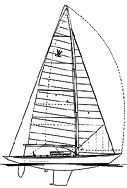W-46
Offshore One-designr
These striking boats are in marked contrast to the "all business" IMS types that dominate current racing, and why not? Yachting has always been a lifestyle statement, so why not explore the styling options.
Do you give up performance when you abandon the snubbed-off ends and suppositorylike deck structures of the modern race boats? Yes, you do, if LOA figures largely in your assessment. But what you gain is a piece of functional art and an "escape" vessel capable of taking you out of this digital world and returning you to a time of what is perceived at least to be analog bliss.
The hull form of the 46-footer is similar to that of the bigger boats, with plenty of deadrise and fore and aft rocker to the canoe body. The ends are long and fine; beam is pushed forward, and there is plenty of flam to the bow sections. The sheerline is sprung with confidence, and the transom is tiny. The D/L is 199 based on an "approximate" displacement of 16,000 pounds. Beam is narrow with an L/B of 4.18. You can consider any boat with an L/B of 4 or greater as being narrow. For fun, the DWL is 72 percent of the LOA. Look at the X-562 in these reviews. It has an DWL/LOA of 86 percent, i.e. more sailing length for its LOA. Draft is 8 feet with a moderate-aspect-ratio bulbed fin. The carbon fiber rudder is a semibalanced spade with a long chord.
We've come full circle with the rig. The fractional rigs of the past are now back in fashion. Of course this particular rig features swept spreaders and a carbon fiber mast and boom. An asymmetrical chute will be carried from the masthead. The SA/D of this design is 24.3, and that is certainly in keeping with modern designs.
The deck plan features a "period" cabintrunk. I'd prefer to see a little more shape to this item. Even some older boats had shapely deck structures. This trunk appears to have no taper to the sides at all, and to my eye, it looks authentic but awkward. The cockpit is long and T-shaped to make room for the large-diameter wheel. Look at that expanse of deck aft of the cockpit. This is a good place for a noninvolved crewmember to sit while racing. The long, flush foredeck won't do much for headroom below, but it sure looks great and will make sail handling forward easy. The elegance and beauty of this design is obvious in the sailplan.
If you have been sailing fat, squatty, high-freeboard boats, I think you would be amazed at the feel of the W-46. This type of boat usually has a beautiful, gentle and balanced feel to the helm that carries through a wide range of heel angles. The low freeboard means that sitting to leeward you will be close to the water rushing by, and that enhances the feeling of speed. In a one-design or PHRF setting, I don't think the small price you pay in boat speed for this aesthetic is relevant.

Comments